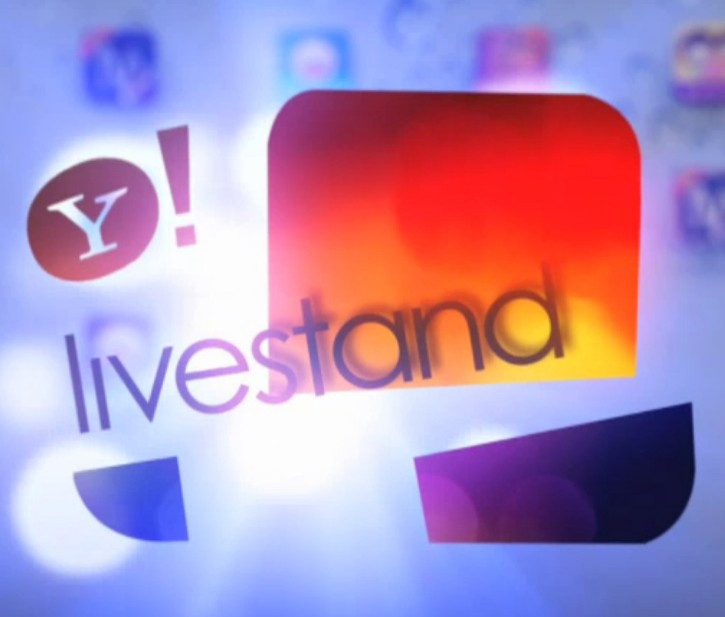Yahoo Livestand Killed Six Months After Debut; CEO Ross Levinsohn Makes First Major Move
Analysis

It seemed like a step in the right direction for Yahoo back in November, when the company announced a family of new mobile products that would enrich the way users experience and understand their news and entertainment content. But just shy of seven months after that outburst of mobile and social apps and tools, Yahoo has decided to call it quits on arguably the biggest piece of that mobile package: the personalized magazine app for iPad, Livestand.
As announced during our most recent earnings call, we've decided to discontinue or consolidate a number of products across Yahoo!'s technology platforms over the course of 2012, Yahoo's Livestand Team wrote on the company blog on Friday. Platform consolidation enables us to put many Yahoo! properties onto common key platforms and technologies to make everything more scalable and nimble. And when we discontinue products, it will be so that we can focus on opportunities where we lead and where we can create the most meaningful experiences for people using our products, and for our partners, developers and advertisers. One of the first decisions we've made along these lines is to discontinue our personalized digital newsstand app, Livestand for iPad.
Yahoo admitted that Livestand received great feedback and even averaged a four-star rating in the App Store, but the company said that it had previously committed itself to shelf what's not working, alluding to the company's decision on Jan. 27 to kill 10 different mobile applications for iPhone, iPad, Android, and BlackBerry devices.
We have learned a lot from Livestand and are actively applying those insights toward the development of future products that are better aligned with Yahoo!'s holistic mobile strategy, the company said. We are pivoting to a mobile-products-first development model (check out Yahoo! Axis as a great example of this) and there's no doubt that one of the biggest, if not THE biggest, priorities for us is to innovate for the mobile user, whether they're using feature phones, smartphones or tablets - or iOS apps, Android apps or mobile web browsers, for that matter.
Yahoo did not announce plans to kill any other of the applications annnounced back on Nov. 2, such as IntoNow, Yahoo's social TV app for the iPad, or the new mobile platform called Cocktails, which was built on the same C.O.R.E. (content optimization relevance engine) technology as Livestand. Cocktails consists of two parts, including Yahoo Manhattan, which uses Yahoo's cloud to distribute apps and content worldwide, and Yahoo Mojito, which automatically packages apps for iOS and Android device formats so developers don't have to write two separate codes. Cocktails supports a blend of HTML5, CSS3, JavaScript, and other Web-based applications, so it's encouraging to know that Yahoo knew its value enough to keep it active.
We know we're headed towards a time when people in all markets will actually use the web more on connected devices like phones, tablets, TVs, and consoles than they do on PCs, the company said. We already have millions of people using Yahoo! on mobile phones and tablets each month, and are seeing that number grow rapidly. With all the great things we learned from people's interactions with Livestand, we know we can create beautiful, easy-to-use HTML5 media properties that give the richest experiences to the most people. Stay tuned as we continue to reimagine the products Yahoo! delivers across all the devices you choose to use.
Yahoo is pivoting its business as the company continues to soul search. On April 4, the company laid off more than 2,000 employees -- nearly 14 percent of the company's total workforce -- in order to save the company's hemmoraging business, and about $375 million per year in the process. And then on May 13, the company caught CEO Scott Thompson lying on his resume, gave him the boot, and handed over the interim CEO title to Ross Levinsohn. Levinsohn is now the fourth Yahoo CEO since September 2011, but he hopes to remove his interim title. This move may have something to do with that.
Here's what the Business Insider learned from sources inside Yahoo, who wished to remain anonymous:
The basic outline is this: Levinsohn is, in the short term, going to ignore his own passion for big deals to solve some noisy problems and focus the company. Meanwhile, he'll begin to divest assets in order to build up a pile of cash. Then he's going to swing for the fences, hoping to propel Yahoo into growth even though its core product has already begun to erode.
Levinsohn has made his name on making big deals and swinging for the fences, as Business Insider says. He reportedly was the one to convince Rupert Murdoch to buy MySpace when he worked for NewsCorp. Then he bought it and sold the site's entire ad inventory for nearly $1 billion. He might be trying to focus Yahoo in order to sell it off, but it doesn't seem like the Yahoo board would have a major problem with that, considering what the company has been through recently. The move to kill Livestand probably won't do it alone, but if Levinsohn wants to fatten Yahoo with profits before selling his cash cow, he needs to make it leaner first. Yahoo investors can expect more moves like this if the board decides to keep Levinsohn on full-time.
Approximately 700 million people visit Yahoo sites every month.
© Copyright IBTimes 2024. All rights reserved.





















